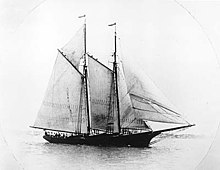Fore-and-aft rig



A fore-and-aft rig is a sailing rig consisting mainly of sails that are set along the line of the keel rather than perpendicular to it. Such sails are described as fore-and-aft rigged.[2]
Description
Fore-and-aft rigged sails include staysails, Bermuda rigged sails, gaff rigged sails, gaff sails, gunter rig, lateen sails, lug sails, tanja sails, the spanker sail on a square rig and crab claw sails.
Fore-and-aft rigs include:
- Rigs with one mast: the proa, the catboat, the sloop, the cutter
- Rigs with two masts: the ketch, the yawl
- Rigs with two or more masts: the schooner
Barques and barquentines are partially square rigged and partially fore-and-aft rigged.
History
The fore-and-aft rig was used around the Indian Ocean since the first millennium, among vessels from the Middle East, Southeast Asia, and China.[3][4]
Europe
The square rig had predominated in Europe since the dawn of sea travel, but in the generally gentle climate of southern Europe and the Mediterranean Sea during the last few centuries before the Renaissance the fore-and-aft began to replace it. By 1475, their use increased, and within a hundred years the fore-and-aft rig was in common use on rivers and in estuaries in Britain, northern France, and the Low Countries, though the square rig remained standard for the harsher conditions of the open North Sea as well as for trans-Atlantic sailing.[5]: p.49 The triangular lateen sail was more maneuverable and speedier, while the square rig was clumsy but seaworthy.
References
- ^ Casson, Lionel (1995): "Ships and Seamanship in the Ancient World", Johns Hopkins University Press, ISBN 978-0-8018-5130-8, pp. 243–245
- ^ Knight, Austin Melvin (1910). Modern seamanship. New York: D. Van Nostrand. pp. 507–532.
{{cite book}}: Cite has empty unknown parameter:|coauthors=(help) - ^ Hobson, John M. The Eastern Origins of Western Civilisation. Cambridge University Press,2004, p. 58, ISBN 978-0-521-54724-6, ISBN 0-521-54724-5 "
- ^ Agius, Dionisius A. (2008). Classic Ships of Islam: From Mesopotamia to the Indian Ocean. BRILL. pp. 141, 160, 211–212, 382. ISBN 9004158634.
- ^ Chatterton, Edward Keble (1912). Fore and aft. London: J. B. Lippincott. OCLC 651733391.
{{cite book}}: Cite has empty unknown parameters:|editorn-first=and|editorn-last=(help)
